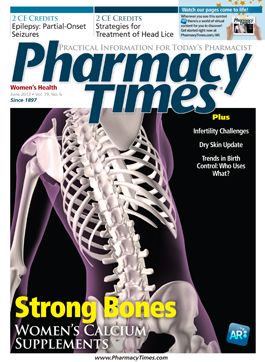Publication
Article
Pharmacy Times
Beta-Blockers and Beta-Agonists: What Is the Risk?
Non-cardioselective beta-blockers appear to pose the greatest risk to patients with asthma or COPD.


Non-cardioselective beta-blockers appear to pose the greatest risk to patients with asthma or COPD
The potential interaction between beta-blockers and beta-agonists is a classic example of a pharmacodynamic drug interaction. It would appear that the administration of beta-blockers to patients taking beta-agonists should be avoided in all cases and some have recommended this action. However, differences in the activity of beta receptors and receptor selectivity of drugs binding to beta receptors add a level of complexity that precludes broad drug class—based interaction recommendations.
Beta-blockers and Beta-agonists in Asthma
Beta-agonists are commonly used in the treatment of asthma and chronic obstructive pulmonary disease (COPD). Beta-blocker use in asthma has been widely studied. In general, cardioselective beta-blockers (eg, acebutolol, atenolol, bisoprolol, celiprolol, metoprolol) appear to be effective for the treatment of thyrotoxicosis, tachyarrhythmias, hypertension, heart failure, and acute coronary syndrome without increased risk of asthma exacerbation.1,2
In an analysis of 10 studies on the effect of beta-blockers in patients with asthma where selective beta-blockers were administered for up to 14 weeks, there was no change compared with placebo in FEV1, symptoms, or inhaler use.1 Further, the use of selective beta-blockers following the administration of a beta-agonist produced a greater increase in FEV1 than placebo. While there are few data on the use of non-cardioselective beta-blockers (eg, carvedilol, nadolol, pindolol, propranolol, timolol) in patients with asthma, it would seem prudent to avoid beta-blockers that inhibit the beta-2 receptor in patients using beta-2 agonists.
Beta-blockers and Beta-agonists in COPD
A number of studies have evaluated the use of beta-blockers in patients with COPD.1,3-7 As was observed in studies in patients with asthma, COPD patients being treated with beta-agonists showed no detrimental effects (reduced airway function or disease exacerbations) of cardioselective beta-blockers.1,4 A retrospective study of COPD patients reported that those taking beta-blockers were less likely to have an exacerbation of their disease and this result was independent of the cardioselectivity of the beta-blocker.5 However, more than 75% of the patients were receiving a cardioselective beta-locker, limiting the ability of this study to assess the relative risk of beta-blockers based on cardioselectivity.
Other studies have noted a similar tolerance to nonselective beta-blockers in COPD patients.8,9 The effect of metoprolol 95 mg, propranolol 80 mg, and metoprolol 190 mg on the response to salbutamol was assessed in patients with COPD.6 There was no difference in FEV1 at baseline or following methacholine challenge with any beta-blocker compared with placebo. Recovery of the FEV1 after methacholine administration followed by salbutamol inhalation was reduced by both propranolol and the higher dose of metoprolol but not the low metoprolol dose. Similarly, the post-methacholine recovery of FEV1 following formoterol inhalation was reduced by propranolol 80 mg but not by metoprolol 100 mg or celiprolol 200 mg.7
Summary and Recommendations
Non-cardioselective beta-blockers appear to pose the greatest risk in patients with asthma or COPD. A decreased response to beta-agonists seems to be the most commonly observed effect of non-cardioselective beta-blockers in these patients, although increased airway hyperresponsiveness was observed with both types of beta-blockers.
Cardioselective beta-blockers, administered at doses that maintain cardioselectivity, appear to present limited risk in patients with asthma or COPD, even if beta-agonists are administered. Since there is little benefit to administering a non-cardioselective beta-blocker, it would be prudent to select a cardioselective one for patients with pulmonary disease who require beta-blockade.
Drs. Horn and Hansten are both professors of pharmacy at the University of Washington School of Pharmacy. For an electronic version of this article, including references if any, visit www.hanstenandhorn.com.
References
- Salpeter SR, Ormiston TM, Salpeter EE. Cardioselective beta-blockers in patients with reactive airway disease: a meta-analysis. Ann Intern Med. 2002;137:715-725.
- Self T, Soberman JE, Bubla JM, Chafin CC. Cardioselective beta-blockers in patients with asthma and concomitant heart failure or history of myocardial infarction: when do benefits outweigh risks? J Asthma. 2003;40:839-845.
- Salpeter S, Ormiston T, Salpeter E. Cardioselective beta-blockers for chronic obstructive pulmonary disease. Cochrane Database of Systematic Reviews. 2005, issue 4, CD003566.
- Salpeter SR, Ormiston TM, Salpeter EE, Poole PJ, Cates CJ. Cardioselective beta-blockers for chronic obstructive pulmonary disease: a meta-analysis. Resp Med. 2003;97:1094-1101.
- Farland MZ, Peters CJ, Williams JD, Bielak KM, Heidel RE, Ray SM. Beta-blocker use and incidence of chronic obstructive pulmonary disease exacerbations. Ann Pharmacother. 2013;47:651-656.
- Chang CL, Mills GD, McLachlan JD, Karalus NC, Hancox RJ. Cardioselective and non-selective beta-blockers in chronic obstructive pulmonary disease: effects on bronchodilator response and exercise. Intern Med J. 2010;40:193-200.
- van der Woude HJ, Zaagsma J, Postma DS, Winter TH, van Hulst M, Aalbers R. Detrimental effects of beta-blockers in COPD: a concern for non-selective beta-blockers Chest. 2005;127:818-824.
- Rutten FH, Zuithoff NP, Hak E, Grobbee DE, Hoes AW. Beta-blockers may reduce mortality and risk of exacerbations in patients with chronic obstructive pulmonary disease. Arch Intern Med. 2010;170:880-887.
- Kotlyar E, Keogh AM, Macdonald PS, Arnold RH, McCaffrey DJ, Glanville AR. Tolerability of carvedilol in patients with heart failure and chronic obstructive pulmonary disease or asthma. J Heart Lung Transplant. 2002;21:1290-1295.

Newsletter
Stay informed on drug updates, treatment guidelines, and pharmacy practice trends—subscribe to Pharmacy Times for weekly clinical insights.






